Although I am a Victorianist, I started my graduate studies as a student of the Renaissance, working under A. C. Hamilton at Queen’s University in Canada. That interest has continued to influence my teaching through a series of courses on the longue durée history behind my eventual area of specialization (nineteenth-century literature and culture), culminating in two courses I have taught for Purdue’s Honors College: Making the Human (spring 2017) and Leonardo da Vinci (spring 2018). Since the paradigm shift from the medieval period to the Renaissance impacted every single discipline (STEM as much as the humanities), that shift serves as a perfect subject for an interdisciplinary honors college course that seeks to bring together engineers and English majors, astronomers and art historians. More than half of each class was made up, in fact, of engineers of one stripe or another.
Such a course offers the challenge of finding assignments that are as interesting to engineers as they are to English majors. The COVE’s timeline tool provided me with just such an instrument: a way to make sense of the emergence of our current ways of thinking while we explored the transformation of our notion of time itself.
First, the assignment:
Create a timeline in preparation for your final paper assignment. For this exercise, I will ask you to use a timeline tool that I have been creating for general use, so you will be serving also as beta testers of the tool and of its interface. Your timeline should include a minimum of seven items that clarify or set in context the object or event you will be examining in your final paper. Be sure to support the timeline with appropriate images; you might consider using Wikimedia Commons as a resource for this: just make sure that you properly state fair use or public domain status of the images and provide information about the source of the image.
The students then went to work. Amazingly, they required next to no help from me. In COVE, you can easily create a course space where you keep track of activity by your students (Figs. 1 and 2).
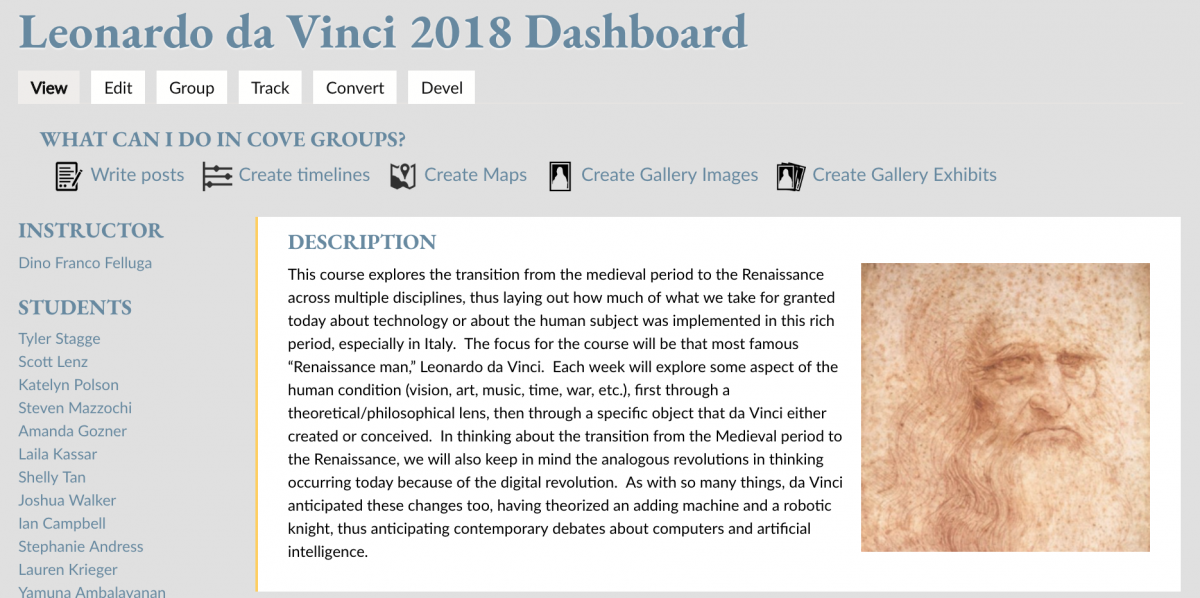
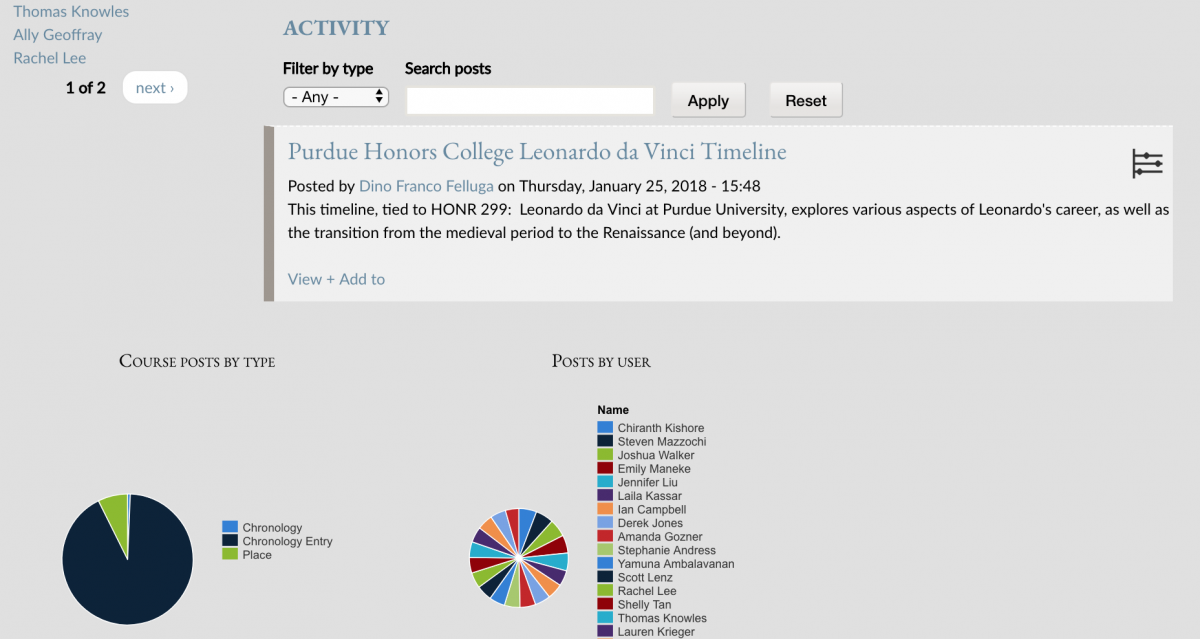
Figs. 1 & 2
The timeline itself, an adaptation of the open-source tool TimelineJS, can be either a single student’s project or an activity undertaken by the entire class. For my courses, I wanted students to see each other’s work so we created a communal timeline. With 19 students doing at least 7 timeline events each, we quickly had a rather rich shared timeline of over 133 events. Astronomers could explore the history of the telescope. Engineers could lay out Leonardo da Vinci’s various designs for bridges or mortars or ballbearings. Students thus learned from each other in ways that they told me, at the end of the course, they appreciated. One student’s comments were repeated by many others: “I enjoyed this group project because it was a mixture of independent and collaborative work. Each student was able to work on their own timeline entries, yet we worked together by building a full timeline. This was a unique combination which was interesting.”
Grading was facilitated by the fact that you can easily call up any one student’s course activity (Fig. 3).
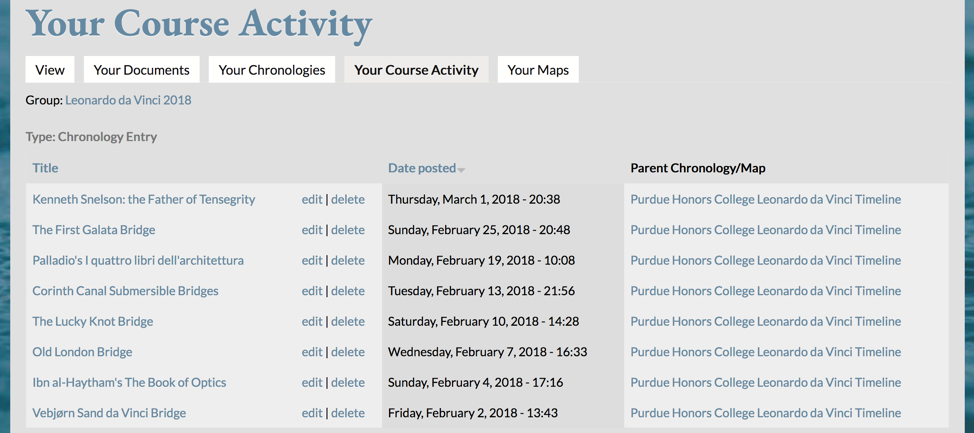 Fig. 3
Fig. 3
As you can see, this particular student (Emily Maneke, a triple major in Building Information Modeling, Virtual Product Integration, and Computer Graphics Technology) was interested in Leonardo’s bridge designs. The timeline allowed her to research the history of bridge-building in preparation for her final paper, on Leonardo’s own designs. Her own mini-timeline culminates with Vebjørn Sand’s implementation of Leonardo’s parabolic arch design, originally intended for the Golden Horn of present-day Istanbul (Fig. 4).
 Fig. 4
Fig. 4
Since the COVE timeline-builder is interlinked with COVE’s map-builder tool (an adaptation of OpenLayers), she was also able to link the timeline to a precise geolocation for the bridge: over European route E18 in Ås, Norway (Fig. 5).
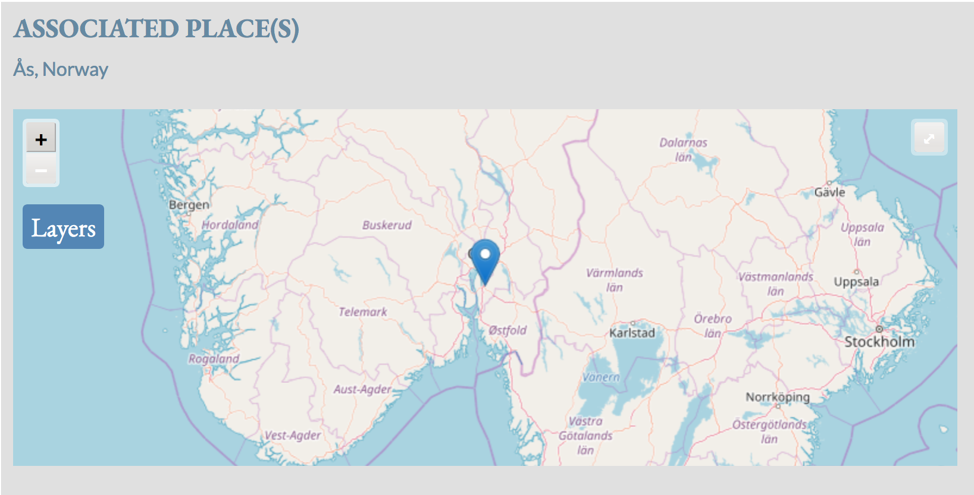 Fig. 5
Fig. 5
The student was able to do this on her own, using the map-builder’s user-friendly interface. I never needed to intervene, not even to provide guidance on how to use the tool. Students figured that out on their own. Of course, these are honors students, who tend to be more self-assured than your average student, but I was nonetheless impressed by how quickly students took to the interface. Indeed, students uniformly commented on the ease of use, especially of the timeline-builder: “I really enjoyed seeing the progression of the timeline as everyone added their entries. Also, once it was clear how to add an event, the tool was simple to use”; “It was user friendly”; “It was very user friendly and was really interesting to look at”; “I liked how easy it was to input information for each timeline entry”; “I like that it is easy to navigate in the timeline and that there is both a visual timeline represented and a list of events in chronological order so you can navigate. I also liked that you could search for events by keyword and that the entries were easy to edit”; “This type of collaboration was not only great for learning and providing a plethora of useful information, but was also very easy and was not stressful like some collaborations are.”
Since the class was made up of so many engineers, I also included a build assignment. If you can bear with me, I’d like to take a moment to describe this assignment as well since it links up with Emily’s timeline and with my final point about the value of active doing, addressing humanities/STEM interdisciplinary pedagogy along the way. Here’s the assignment:
Build a machine, following the images and text in da Vinci’s notebooks. It need not be a complex machine—it could be as simple as a set of pulleys or a device that makes use of ballbearings. Students going on the da Vinci study-abroad program will serve as team leaders, having photo-documented reconstructions of da Vinci’s inventions at an exhibit in Venice. You will be aided in this assignment by Steve Wereley, who will serve as consultant from Purdue’s Mechanical Engineering program.
As it happens, Emily Maneke went on that 2-credit study-abroad program, served as team leader, presented on a reconstruction of Leonardo’s self-supporting bridge design at the Leonardo Museum in Venice, and then built the self-supporting bridge with four other students in the Leonardo course after she returned. Below, you can see them building the bridge while giving their in-class presentation on what they learned.
Fig. 6
The following weekend, students exhibited their designs to elementary- and middle-school kids coming to Purdue’s annual Spring Fest. Kids visiting the Honors College tent could build a small version of the bridge design created with a 3D printer (pictured in Fig. 7) or the larger version, which you can see on the ground.
 Fig. 7
Fig. 7
The class timeline was also on display at Spring Fest, where visitors could see Emily’s timeline events about bridge design. Since the timeline works perfectly on an iPad, parents and kids could scroll our class timeline at this public forum (Fig. 8).
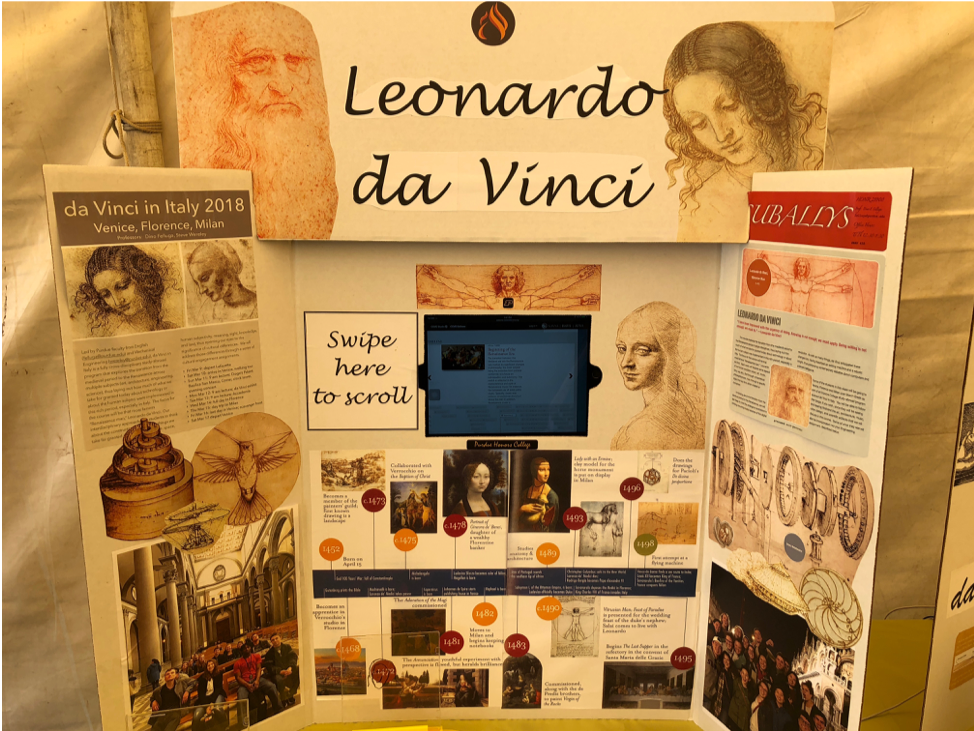
Fig. 8
The course syllabus (or suballys, as you see above—a playful reference to Leonardo’s mirror-writing) begins with a mantra from Leonardo’s notebooks that we took as our own: “I have been impressed with the urgency of doing. Knowing is not enough; we must apply. Being willing is not enough; we must do.” I tried in this course not only to impart knowledge through lectures but also to do. Not only did students learn about the new theorization of 3-dimensional illusionistic space after Filippo Brunelleschi and Leon Battista Alberti, for example; they also built a perspectograph based on Leonardo’s notebook design for such an instrument, which Leonardo used to perfect his technique. Most students built these out of cardboard, after which we invited a Purdue Professor of Fine Art, Christine Wuenschel, to class so she could teach everyone how to draw properly using the devices, following Alberti’s geometric principles. One student, Katie Polson (who is studying mechanical engineering), then constructed a more sturdy version of the perspectograph for Spring Fest using a 3D printer so that others could learn to “draw like Leonardo” at the event (Fig. 9).
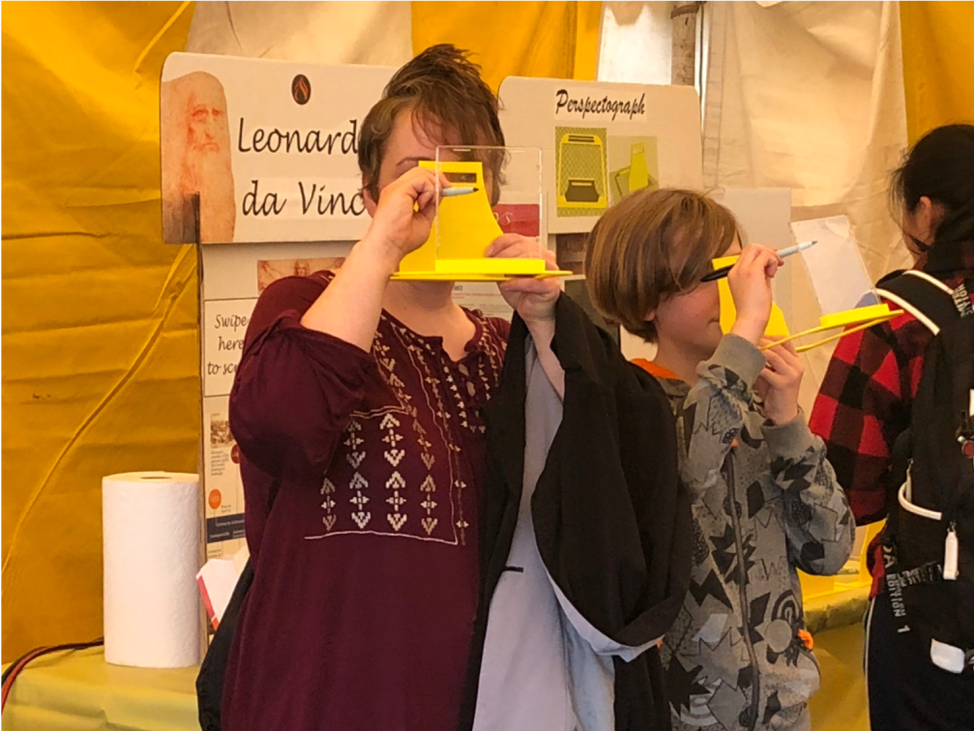 Fig. 9
Fig. 9
I have taken Leonardo’s mantra to heart myself as well. I have attempted not only to use new tools in my teaching; I have also tried actively to build ones that can help me engage with students in ways that allow them to build things on their own in turn. I am not advocating that we not teach the skills involved in a research essay, mind you—students finished my course with a traditional 1000-word essay, for which they were prepared with other writing assignments. What these new tools do make possible is a richer understanding of the topics students wish to explore, providing them with better support for their final papers: a better grasp of the temporal sweep of the issues under discussion, an understanding of the geospatial locations for the things they discuss, and a more visceral understanding of various terms under discussion in the course.
I fear that it can be easy to be dispirited as a humanities professor in the present day. Liberal Arts colleges across the United States have seen a drop in enrollment; faculty are not getting replaced as they depart or retire; funding is going elsewhere; it is becoming increasingly difficult to publish any aspects of our knowledge deemed too arcane by cash-strapped publishers; commercial providers are charging our libraries outrageous amounts for access to our own scholarship. Our response, I feel, should not be despair. Knowing these facts is not enough. We must do something about it. The COVE is one effort to bring us together in a way that shows to the world the value of what we do. It is an effort also to reclaim the means of production so that, as humanities scholars, we can take back control of the products of our labor, thus countering the stranglehold that commercial providers increasingly have on our cultural heritage. Being willing is not enough; we must do.
